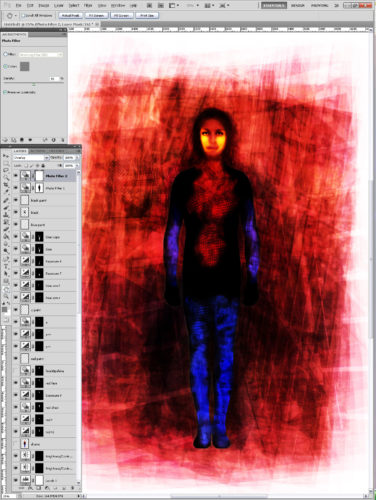These are entirely composited, fictitious people. Each image includes 30 to 50 exposures of different models including different ethnicity, gender, body types, fashion, and environments.
My process simulates multiple exposure using high multiple individual images usually selected for either a common theme or composition, or both. The images are aligned, opacity screened to equal one properly exposed image, and colour contrast scheme enhanced.
This Adobe Photoshop™ screen capture (from Emotion series) shows some of the image process steps. Not shown are the 33 individual photograph layers and some additional opacity control keys.
Whereas film multiple exposure compensation is adjusted according to log2n, n = number of exposures, this does not translate well to digital domain. Paradoxically, film multiple exposure is built up of “barely there” or severe underexposures, digital multiple exposure is built up of high multiples of properly exposed images adjusted to “barely there” or similar severe underexposures.
There are multiple techniques to simulate multiple exposure in digital domain including:
- Using analog film multiple exposure compensation, log2n cascading-less exposure percentage limits effective stack to 10 images because from exposure 1 down the 9th contributes 10% and succeeding exposures contribute 9.xx%. Although historically “authentic”, 10 images are not enough for a chaotically beautiful high multiple composite.
- Using opacity screening only, any number of multiple exposures can be stacked, limited only by computer processing capability and image editing program. Also, depending on aesthetic composition, unequal opacities are acceptable.
In my process, using opacity screening, effective individual exposure contribution cut off occurs at about 50 images, i.e. lots of <2% opacity images do not contribute much other than extra work, also 100+ exposure stack defaults to soft blurry average. To develop my aesthetic concept, some high multiple composites opacity are adjusted unevenly, this was a pure serendipitous discovery when struggling with a composite that had great chaotic beauty but was just weak.
Even fictitious people have stories to tell, serendipitously emerging, mysterious, waiting to be discovered amidst chaotic beauty. Sometimes the story appears during composition. Other times the story jumps out at completion: here I am, let me tell you about myself.
“Photography is the easiest medium to master but the most difficult to have personal vision.” – Chuck Close, 2012.
